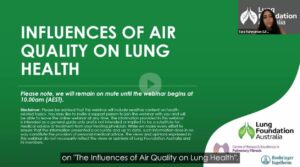In this webinar, Professor Fay Johnston & Associate Professor Luke Knibbs provide insights into the effects of air quality on lung health. Our guest speakers discuss outdoor air pollution, bushfires, wood smoke and provide key takeaways for those living with a lung condition.
Air pollution, particularly nitrogen dioxide (NO2) and fine particulate matter (PM 2.5), poses significant health risks. These pollutants come from various sources, including vehicle emissions, industrial activities, and natural events like bushfires. PM 2.5 particles are tiny and can penetrate deep into the lungs, causing serious health issues.
Long-term exposure to PM 2.5 is linked to increased risks of lung cancer, chronic obstructive pulmonary disease (COPD), and lower respiratory infections. Even short-term exposure can exacerbate asthma and other respiratory conditions. The Australian Institute of Health and Welfare (AIHW) reports that PM 2.5 contributes to a notable percentage of deaths from these diseases.
In Sydney, major sources of NO2 and PM 2.5 include vehicle emissions and domestic activities like wood burning. In contrast, industrial activities are a significant source of PM 2.5 in Newcastle. This variation highlights the need for targeted interventions based on local pollution sources.
Reducing exposure to air pollution involves regulatory measures, technological advancements, and individual actions. Regulatory interventions, such as banning leaded petrol, have proven effective. Technological solutions include improving vehicle emissions standards. Individuals can reduce exposure by avoiding pollution hotspots and using air cleaners.
Research continues to explore the health impacts of air pollution and effective ways to mitigate these risks. Studies show that long-term exposure to air pollution can lead to chronic health issues, emphasising the importance of ongoing efforts to reduce pollution levels.
For those with chronic illnesses, managing health and staying informed about air quality is crucial. Tools like the AirRater app and resources from local environmental agencies can help individuals protect themselves from the harmful effects of air pollution.
Was this page helpful?
Good job! Please give your positive feedback
How could we improve this post? Please Help us.




